Water science is awesome! This water density experiment with sugar uses only a few kitchen ingredients but produces an amazing science experiment for kids! Water experiments for kids make great hands-on learning projects for kids! In this experiment, kids will explore the density of liquids, things that dissolve in water, and color mixing.
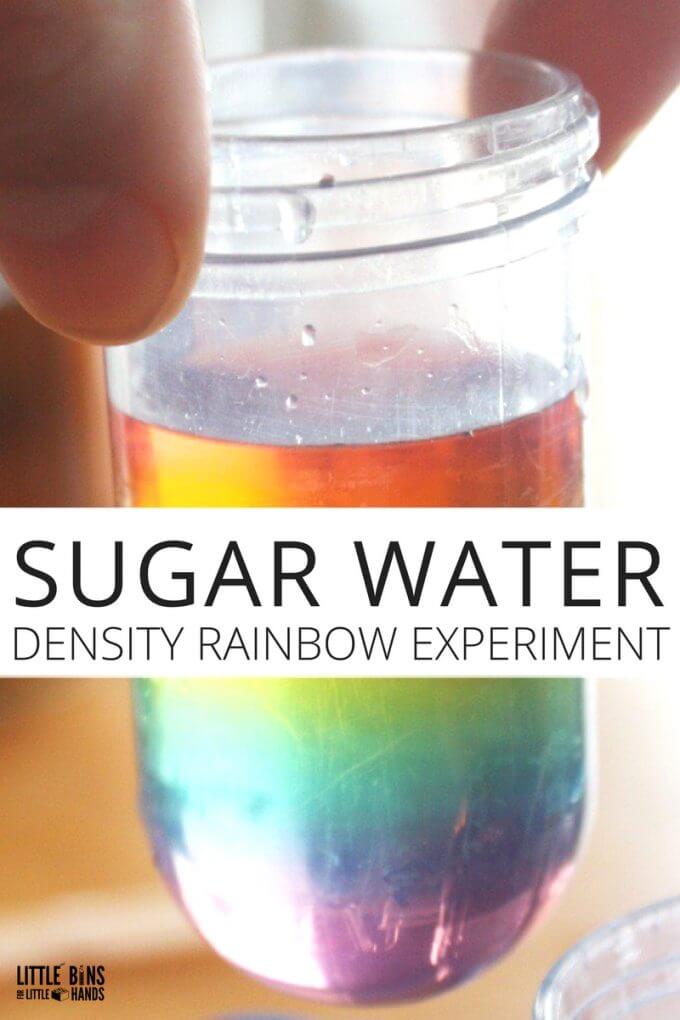
Why is Science for Kids so Important?
Kids are curious and always looking to explore, discover, check out, and experiment to discover why things do what they do, move as they move, or change as they change!
Science learning surrounds us, inside and out. Kids love checking things out with magnifying glasses, creating chemical reactions with kitchen ingredients, learning about solids that dissolve in liquids, and exploring stored energy!
Look through all our Simple Kitchen Science Activities for home or school use!
Use the Scientific Method
This rainbow water density experiment is a fantastic opportunity to use the scientific method and record your experiment using the free mini worksheet pack below.
You can read about using the scientific method here, and find more information on the independent and dependent variables used in the density experiment below!
The first step in the scientific method is asking a question and developing a hypothesis.
What do you think will happen when you add one mixture of sugar and water to another? I think the mixtures will___________. This is the first step to diving deeper into science with kiddos and making connections!
Water Density Science Fair Project
You can also easily turn your water density experiment into a fantastic presentation along with your hypothesis. Check out the resources below to get started.
What is Water Density?
Density is all about the compactness of stuff in space. For this experiment, the more sugar in each glass of water, the greater the density of the water. Same space, more stuff in it!
The denser the substance, the more likely it will sink. This is how our rainbow sugar water density tower works! Learn more about density!
Increasing the amount of sugar in the solution but keeping the water constant creates solutions with increasing densities. The more sugar you mix into the same amount of water, the higher the density of the mixture. So, density explains why the colored sugar solutions stack on top of each other inside the baster.
You could vary this water density experiment by looking at the density of different concentrations of salt dissolved in water!
YOU MAY ALSO LIKE: Viscosity Experiment For Kids
How to Make a Rainbow in a Jar
Note: You can also try a similar sugar water density activity with a Skittles rainbow in a jar.
SUPPLIES NEEDED:
- 4 Glasses or cups
- warm water and 1 cup measuring cup
- sugar and measuring teaspoon
- food coloring
- spoon and baster
- test tubes
INSTRUCTIONS:
Recommended age: I suggest this experiment for upper elementary through middle school and beyond. It is not suitable for younger kids without plenty of adult assistance.
STEP 1: Set out 6 glasses. Measure 1 cup of water into each glass. This is a great time to explain the importance of all the glasses having the same amount of water! You can read more about the scientific method for kids.
STEP 2: Add a few drops of food coloring to each glass of water. You could have your child mix the colors or help them with mixing the colors!
Note: From experience, we have found that 4 colors are the easiest to work with!
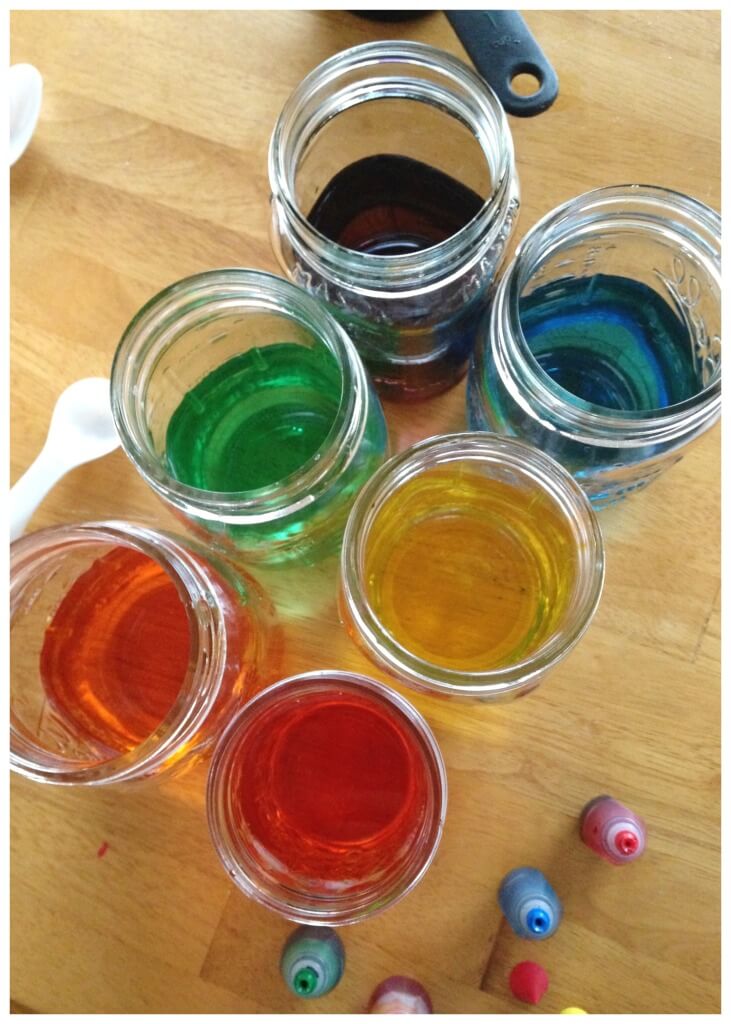
STEP 3. Measure and add a different amount of sugar to each glass of colored water. We have since cut our experiment down to just 4 colors, but you can experiment with all of them.
- RED COLOR – 2 TBSP
- YELLOW COLOR – 4 TBSP
- GREEN COLOR – 6 TBSP
- BLUE COLOR – 8 TBSP
STEP 4. Stir until as much of the sugar is dissolved as possible.
STEP 5. Use your baster or pipette to create a colorful rainbow in a jar.
Tip: Have your child try two colors for an easier version!
- Squeeze the baster and put it in the red water. Release a little of the pressure to suck up some red water.
- Keep the baster squeezed, transfer it to orange, and release more to suck up some orange water.
- Continue to do this for all the colors. Leave enough pressure in the baster to get you through all six colors.
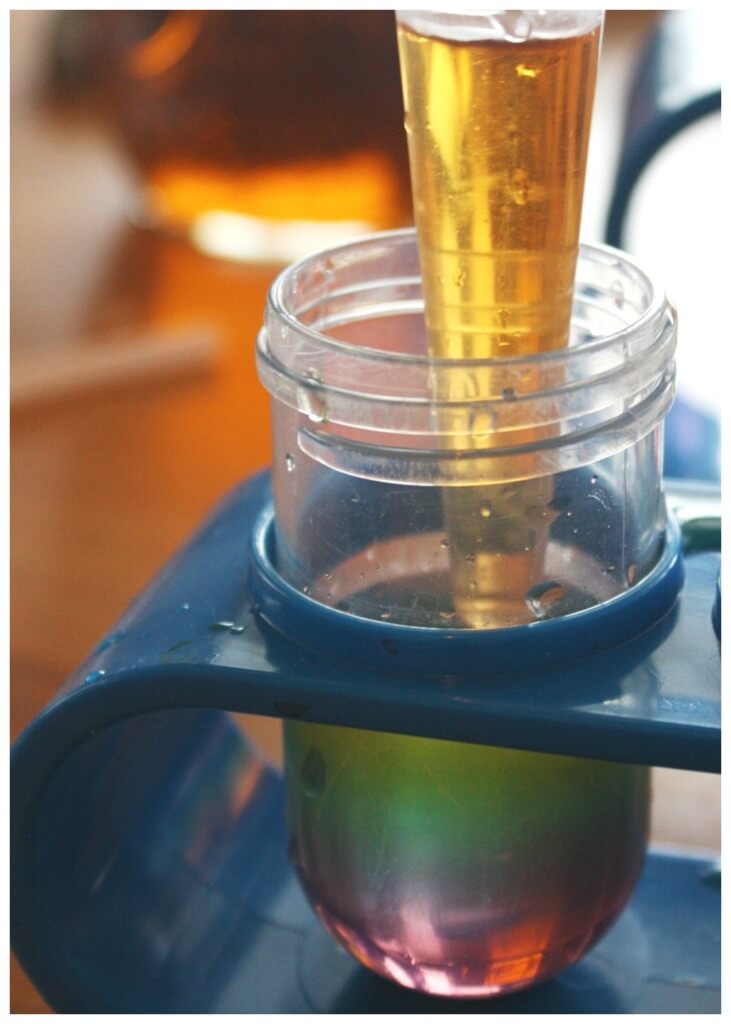
Create a Rainbow Water Density Tower
NOTE: This is probably a better experiment for elementary school or with a very patient kid. My son enjoyed trying to make the tower and simply experimenting with mixing colors.
This rainbow sugar water density tower does take a slow hand and patience.
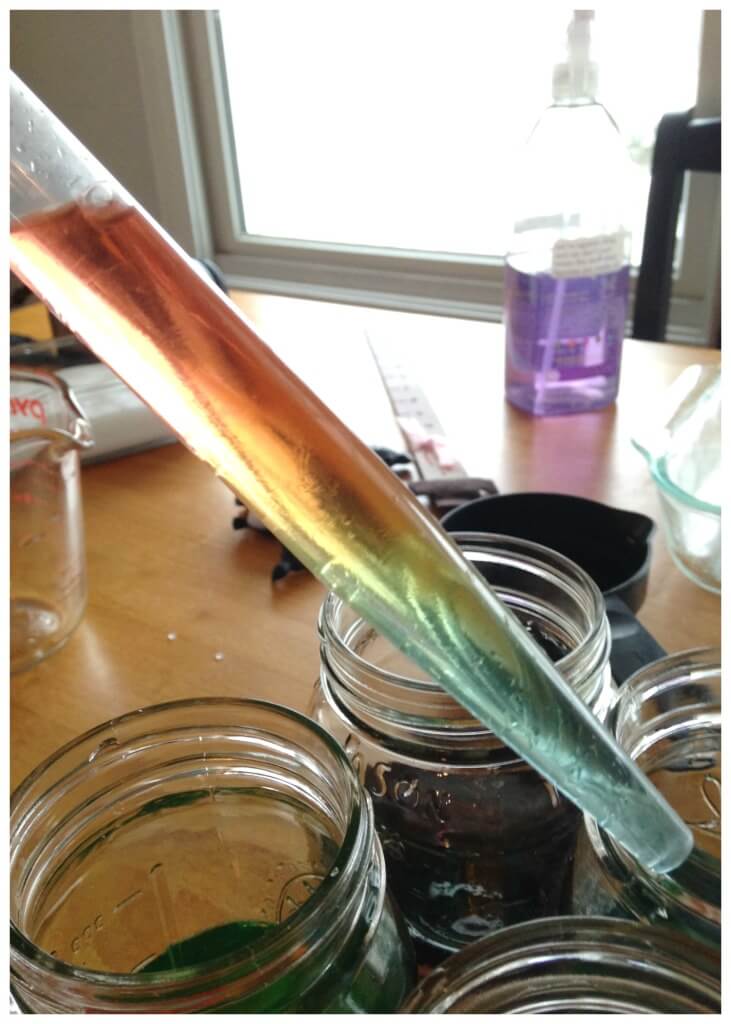
We used a test tube from our favorite science kit! This time we found starting with the densest water {purple} worked the best.
STEP 1: Use the baster’s measuring marks to ensure you get the same amount of each color. Add the purple to the tube.
STEP 2: Next, add the blue, but add the blue very, very slowly. Slowly release the water along the jar’s side or glass.
STEP 3: Continue to do the same thing, working your way back through the colors. Slow and steady. We practiced a few times before we got a full rainbow.
You can experiment with different methods and challenge your kids to come up with a plan of action to make a rainbow in a jar.

We kept our artificial rainbow around for a couple of days. It’s so pretty in the light!
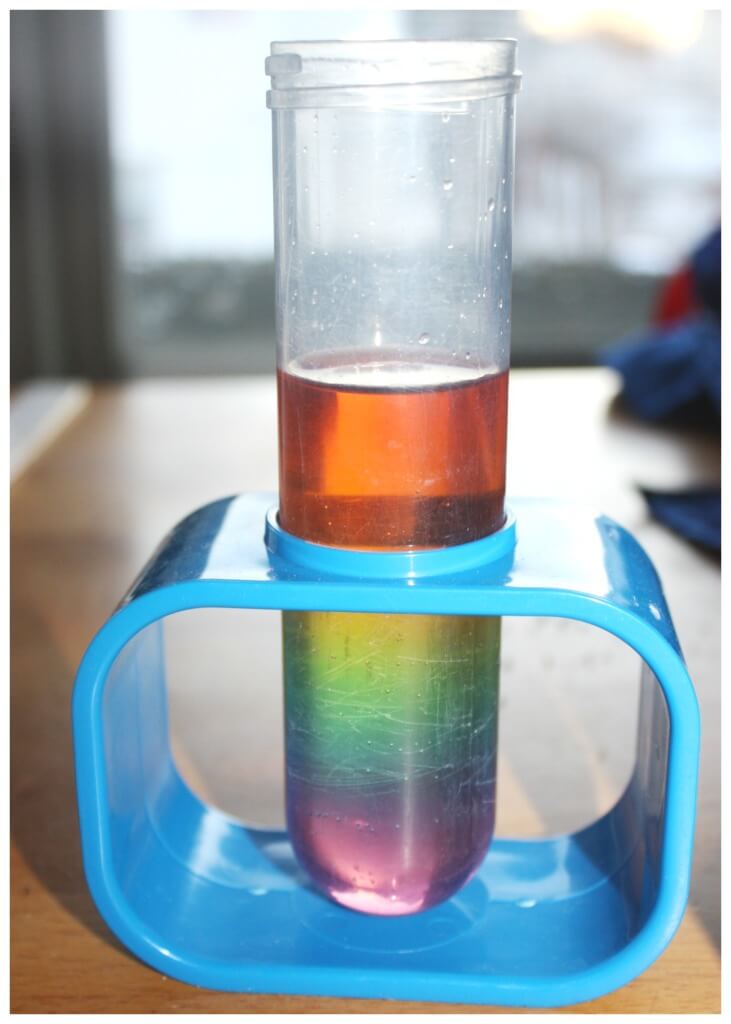
More Density Experiments to Try
You could also try a density tower with various liquids or even a homemade lava lamp to learn more about density.
Or how about a floating egg to demonstrate salt water density?
Check out this oil and water science with a fish theme for a preschool-friendly density activity.
More Science Experiments for Kids
Let’s look at even more awesome everyday science experiments every kid should try!
More Helpful Science Resources
SCIENCE VOCABULARY
It is never too early to introduce some fantastic science words to kids. Get them started with a printable science vocabulary word list. You will want to incorporate these simple science terms into your next science lesson!
WHAT IS A SCIENTIST
Think like a scientist! Act like a scientist! Scientists like you and me are also curious about the world around them. Learn about the different types of scientists and what they do to increase their understanding of their specific areas of interest. Read What Is A Scientist
SCIENCE BOOKS FOR KIDS
Sometimes the best way to introduce science concepts is through a colorfully illustrated book with characters your kids can relate to! Check out this fantastic list of science books that are teacher approved and get ready to spark curiosity and exploration!
SCIENCE PRACTICES
A new approach to teaching science is called the Best Science Practices. These eight science and engineering practices are less structured and allow for a more free**-**flowing approach to problem-solving and finding answers to questions. These skills are critical to developing future engineers, inventors, and scientists!
Printable Science Projects Pack
If you’re looking to grab all of our printable science projects in one convenient place plus exclusive worksheets and bonuses like a STEAM Project pack, our Science Project Pack is what you need! Over 300+ Pages!
- 90+ classic science activities with journal pages, supply lists, set up and process, and science information. NEW! Activity-specific observation pages!
- Best science practices posters and our original science method process folders for extra alternatives!
- Be a Collector activities pack introduces kids to the world of making collections through the eyes of a scientist. What will they collect first?
- Know the Words Science vocabulary pack includes flashcards, crosswords, and word searches that illuminate keywords in the experiments!
- My science journal writing prompts explore what it means to be a scientist!!
- Bonus STEAM Project Pack: Art meets science with doable projects!
- Bonus Quick Grab Packs for Biology, Earth Science, Chemistry, and Physics



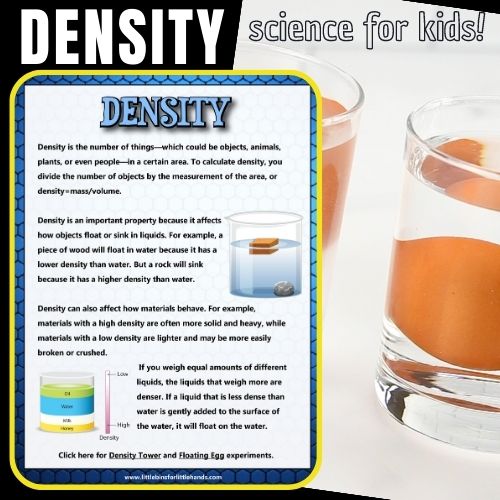







What a super clever and pretty science experiment!
Hello! I tried this experiment with my students today with little success 🙁
The purple and blue separated perfectly, but when green was introduced, it all mixed together from there on.
Any thoughts? I’m so disappointed!! Your’s is PERFECT!!!
i love this website..<3
Thank you. I’ll give this a try at home – and if I am successful I’m sure my students can do it too. 🙂
Hope you have good luck! It might take a bit of practice, but it was fun to experiment.
Practice! We had a few with only a few colors too. You have to go very slowly.
it didnt work yours is perfict
It is a tougher project and you have to be quite slow and patient!
Hello, Iam a science teacher too. Thanks for sharing this experiment with us. But there is a point that ı cannot understand.
To make in a baster, squeeze baster and put in red water. Release a little of the pressure to suck up some water. Keeping it squeezed, transfer to orange, release a little more to suck up some water.
I cant understand these sentences because my english level 🙁 Should I make the test tube oily before pouring the colors? In addition Should I use syringe to take the colored waters in order to pour them? if you can explain i will be really grateful
I found this worked well when I added 4 drops of food colouring per glass rather than 2 drop per glass which I tried first. Try adding milk after, the result is really interesting!
Ours did not work at all. Huge flop even though we followed the directions explicitly. Very frustrating. Super messy. Unsuccessful.
The key is to make sure your sugar ratios are all different so they layers separate and you do need to be slow and patient adding in the layers.
We put a cup of sugar in the purple, half a cup in the blue, quarter cup for green, two tablespoons for yellow, one for orange and none for red. Slowly dribbling each color down the side of the test tube was key to avoid mixing layers.
what grade is this experiment for?
You can use it with a mix of ages but I think it’s best for early elementary age kids. You can add our free science journal page to it as well.
So I tried to do the experiment and I found that if you actually add the different amounts of sugar to Gatorade colors it works for better results.
Nice Blog. very easy process to do this experiment.kids also try this at home.
We tried this experiment with 6 colors, a turkey baster and a large glass cylinder. Epic fail. Brown sugar water was our result.
We found your instructions, tried again and has great success! We used 4 colors, a pipette and shot glasses and it worked beautifully! Adding the subsequent layers VERY slowly was key. The turkey baster had a tendency to dump too much water at a time. The pipette was easier to control. Thank you!
It is a bit more challenging than most of our activities. Starting with just 2 or 3 colors might help!